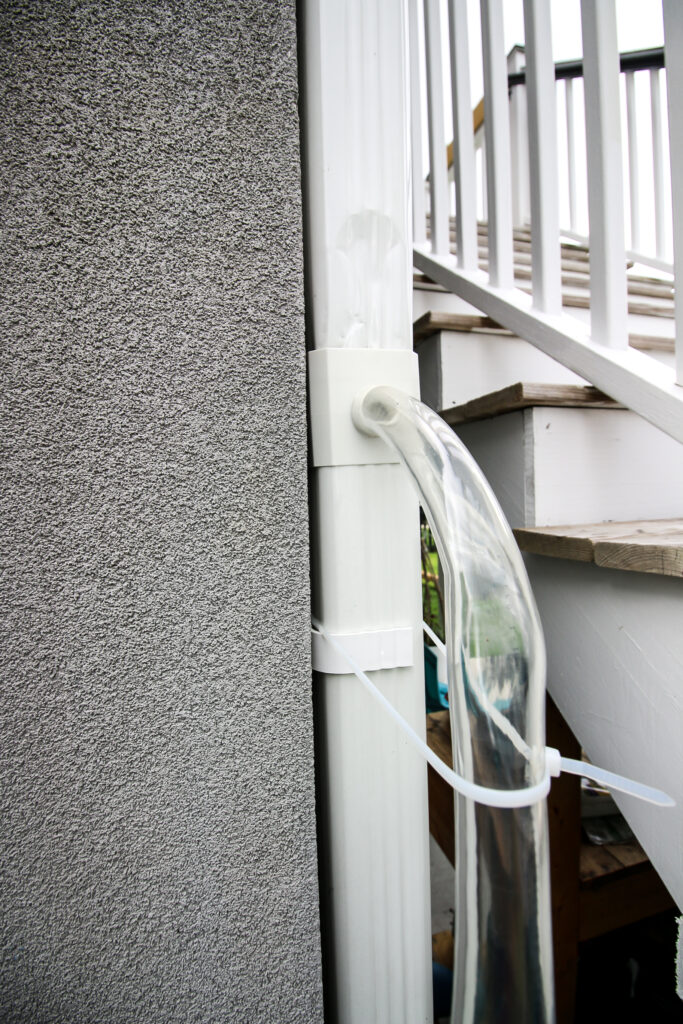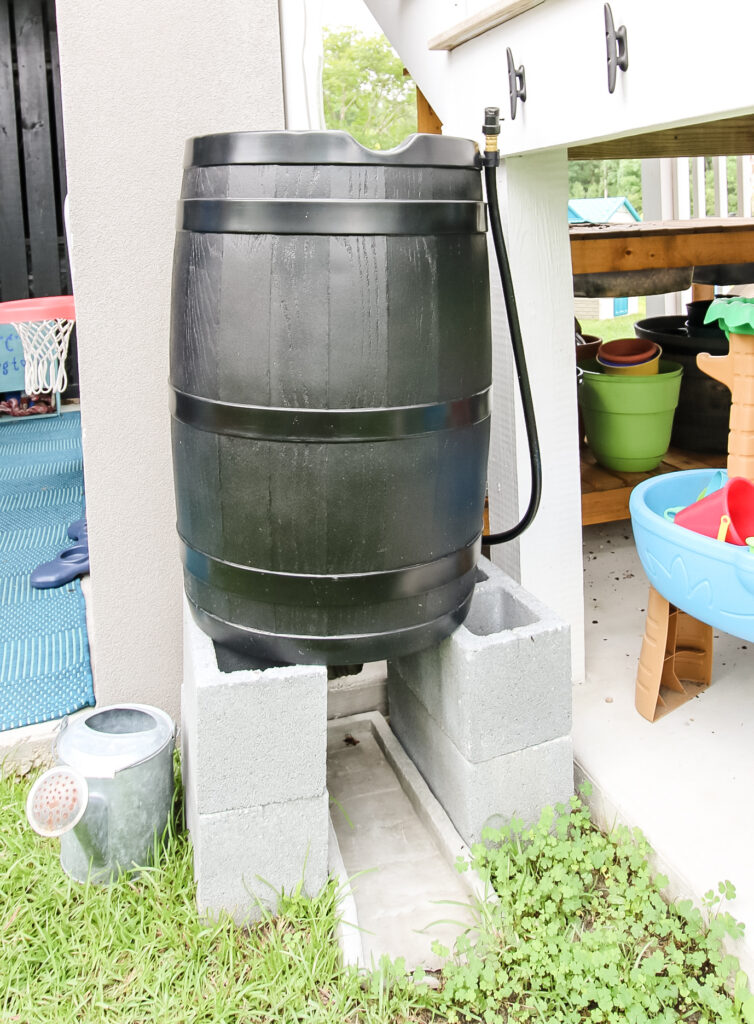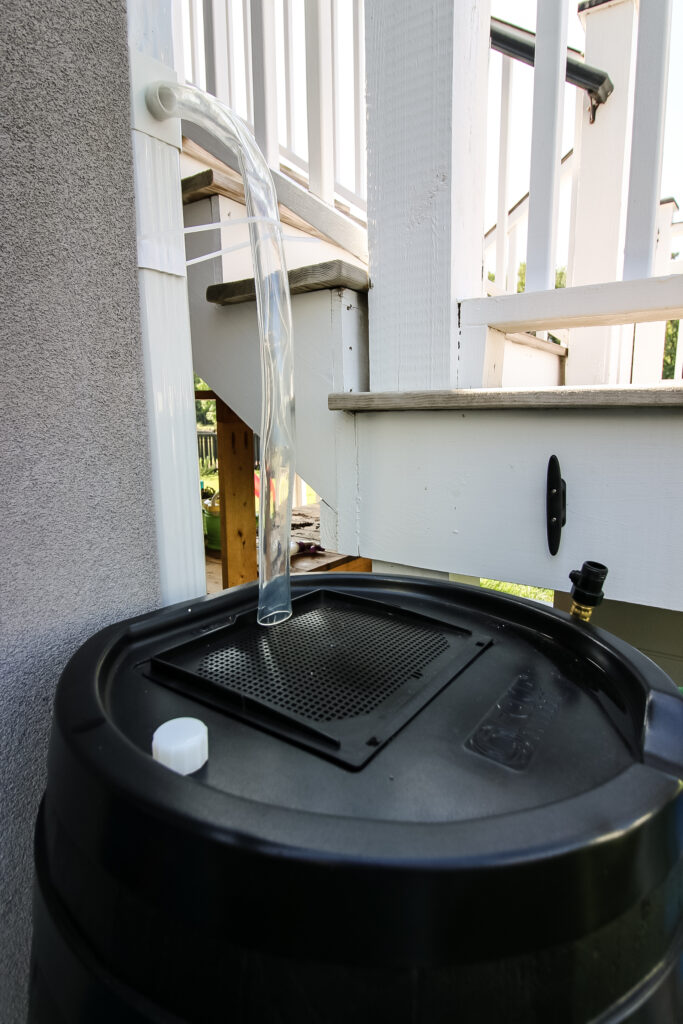Considering adding a rain barrel to your yard? Here is an easy guide on how to set up a rain barrel and lots of rain barrel FAQs!
We try to take steps to be more eco-friendly - like installing solar panels, composting, and recycling or upcycling furniture whenever possible.
One thing I was excited to add to our new home was a rain barrel.
I actually contemplated DIYing a rain barrel from an extra large trash can. But, once I started to add up the necessary parts, I decided that it was actually a better deal to just buy one.
This is the rain barrel that we ordered, installed, and love!

What is a rain barrel?
A rain barrel is a water collection system for your backyard. Rain barrels are typically connected to downspouts on your home to collect and hold water from your roof runoff and gutter system for future use.
What are the benefits of a rain barrel?
There are many benefits to having a rain barrel in your yard.
- Many houseplants prefer rainwater since it is chlorine free - and some even require rainwater or distilled water. Rain water is free!
- You can save money on your water bill by using rainwater instead of paid water
- Rain barrels cut down on storm runoff which can lead to decreased water polution

What are the problems with rain barrels?
There are a few negatives to having a rain barrel.
- They are a bit costly - it cost us around $200 for the barrel, the collection system, the hose, and the cinder blocks to place it on.
- If you live in an area without much rain, it won't be super effective.
Is a rain barrel worth it?
I certainly wouldn't go into debt to buy a rain barrel, but if you like being self sufficient and eco-friendly, it's a great buy. A well-used rain barrel will eventually pay for itself - though it will take a while to do so!

Where is the best place to put a rain barrel?
The best place to put a rain barrel is at the base of a downspout close to the plants or garden that you will be watering. Ideally, it's great to be able to spray plants directly from the barrel! Filling the watering can over and over again can get old.
Additionally, consider the excess runoff from your rain barrel. You want to place it such that the extra water will run somewhere it can easily soak into - not onto concrete or to flood your neighbor's yard.

How high should a rain barrel be off the ground?
Aim to have your rain barrel about 2 feet above the ground. This allows there to be enough water pressure to power the hose, even if the barrel is not super full.
The overall height though needs to be enough that you can fill your watering can below the height of the bottom of the barrel.
What should I put my rain barrel on?
We put our rain barrel on cinder blocks stacked 2 high. This was the perfect height, plus cinder blocks are weather proof and relatively inexpensive to buy.
Whatever you choose to put your rain barrel on needs to be rot-resistant - so stone or concrete work great.
It is essential that your rain barrel be very stable. These suckers get super heavy when full, you do NOT want to risk one tipping over and squashing you, or a child, or even a neighborhood squirrel.

How do you hook up a rain barrel?
Rain barrels typically are placed next to the downspout of a gutter to most easily collect rain water.
To connect the rain barrel to the downspout, you will need a rainwater collection system. This is just a piece that you add to your gutter with a hose attachment, and the hose runs into the rain barrel.
IMPORTANT: measure your downspout! There are different widths and you need a connector that is the right size or it won't fit! We learned this the hard way.
To insert the collection system, you will need a reciprocating saw or hand saw. Measure your downspout (precise measurements vary by product and will be on the packaging) and carefully make 2 cuts to remove a small section of downspout.
Then, slide the collection system in place. Your system may come with a hose (our first one that didn't fit did) - we had to buy tubing (by the foot, I bought 2 feet) separately at Lowes.
Place your rain barrel on cinderblocks or something similar to raise it. Run the hose from the downspout to the top of the barrel. Do NOT remove the cover from the rain barrel, that is what keeps leaves and debris out!

Does a rain barrel have to be attached to a gutter?
You do not have to attach a rain barrel to a gutter and can instead let it be freestanding collecting water. Just know that you won't capture nearly as much water!
We didn't attach our rain barrel to the gutter for 2 to 3 weeks while we procrastinated finishing the install. The barrel did not accumulate much water during that time.

Rain Barrel FAQs
Are rain barrels illegal?
In almost every state in the United States, rain barrels are completely legal. Rain barrels are not illegal in the United States.
There are some states that have certain restrictions surrounding rain barrels, but they are not outright banned anywhere. Rain barrel restrictions typically include how the water is collected and how it is used. In these cases, some states specifically state how much rainwater you can collect, say you can't divert a natural source, or say that you can only use the water outdoors.
In many states and smaller municipalities, homeowners are often offered incentives for having rain barrels as they save resources for the state.
Regardless, be sure to check your city and state regulations for yourself. For more information on rain barrel restrictions in states, check out the World Water Reserve's full breakdown of each state's stand on rainwater.
Should rain barrels be connected at the top or bottom?
Water should flow in to the top of the barrel. The hose or spicket to get water out of the barrel should be close to the bottom of the barrel.
What happens when a rain barrel gets full?
When your rain barrel gets full, it will overflow. That's why you want to use a rainwater collection system on the downspout - when the barrel is full, you can cap it off and it will direct water down the rest of the downspout! Regardless, you will still get some runoff, especially in big storms.
Most rain barrels are designed with a gap around the top lip so that if the barrel gets full, water will flow off the top of the barrel and down the side with no problems.
How often should you empty your rain barrel?
Typically, just using your rain barrel is enough to keep the water from getting stagnant. However, if you are expecting a large rain, try to use up as much of the existing water as possible. This will allow the barrel to fill with new, fresh water.

How long can water sit in rain barrel?
Assuming that your rain barrel is dark colored and sealed off, water will be OK for two weeks. After that, it starts to get a bit funky. Try to use it as much as possible to keep the water flowing and cycling!
Do you need to treat rain barrel water?
Rain water is great for lawns and non-edible plants. The risk to edible plants is that there could be e-coli (from bird poop on the roof, usually) in the water. If you want to use the water for edibles, consider treating the water with bleach just to be safe.
Rain barrel water should be boiled before using it for drinking water.
Do I need to empty my rain barrel for the winter?
Rain barrels can be used year round if temperatures stay above freezing. If you live somewhere cold, it's a good idea to unhook your rain barrel for winter. Drain the barrel and store it upside down.
Will a full rain barrel freeze?
A rain barrel at any level of fullness can freeze if the temperatures get cold enough. The main concern with your rain water freezing is that the frozen water expands, which can lead to the plastic barrel cracking.
If you live somewhere freezing, empty the barrel, cap off the collection tube, and store the barrel upside down to avoid snow or rain accumulation.

Why does my rain barrel smell like rotten eggs?
A foul odor usually indicates bacteria in your rain barrel. Empty the barrel and clean it with bleach before letting it refill again. Try to keep using the water regularly to avoid contamination.
How do you keep rain barrels from getting stagnant?
Rain barrels are great, unless they are filled with murky, stinky stagnant water. To avoid your rain barrel water getting stagnant:
- Use your rain barrel as much as possible to keep the water cycling out.
- Empty the barrel as much as possible before a big rain to let the most possible fresh water in.
- Clean your gutters and roof regularly. The rain barrel is full of roof run off, after all.
- Only use dark colored rain barrels.
- Choose a rain barrel made from food-grade plastic.
- Pick a spot for your barrel out of the sun as much as possible to avoid algae growth.
- Clean your rain barrel with white vinegar as needed.
Any more questions about rain barrels?
Looking for something?
We've been doing this since 2012 so we have a LOT of blog posts!
Search stuff like: Ceiling Projects | DIY Plant Stands | Thrift Flips


Hello, I'm Morgan, half of the creative force behind CharlestonCrafted.com! With a passion for DIY that dates back to 2012, I've transformed three homes and now I'm dedicated to helping others craft their dream spaces. Let's turn your house into a home together!





